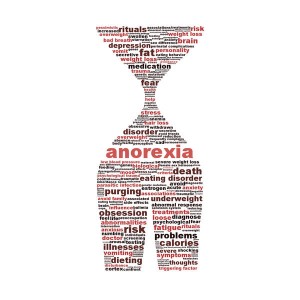 Anorexia Nervosa
Anorexia Nervosa
Anorexia is a life-debilitating mental health disorder that has the highest death rates of any mental health condition. It is one of the most common psychiatric diagnoses in young women. Between 5-20% of individuals struggling with anorexia will die. The probability of death increases within that range depending on the length of the condition. Anorexia typically appears in early to mid-adolescence.
According to the DSM-5 criteria, to be diagnosed as having Anorexia Nervosa a person must display:
- Persistent restriction of energy intake leads to significantly low body weight (in the context of what is minimally expected for age, sex, developmental trajectory, and physical health).
- Either an intense fear of gaining weight or of becoming fat, or persistent behavior that interferes with weight gain (even though significantly low weight).
- Disturbance in the way one’s body weight or shape is experienced, undue influence of body shape and weight on self-evaluation, or persistent lack of recognition of the seriousness of the current low body weight.
Subtypes:
Restricting type
Binge-eating/purging type
Warning Signs
- Dramatic weight loss.
- Preoccupation with weight, food, calories, fat grams, and dieting.
- Refusal to eat certain foods, progressing to restrictions against whole categories of food (e.g. no carbohydrates, etc.).
- Frequent comments about feeling “fat” or overweight despite weight loss.
- Anxiety about gaining weight or being “fat.”
- Denial of hunger.
- Development of food rituals (e.g. eating foods in certain orders, excessive chewing, rearranging food on a plate).
- Consistent excuses to avoid mealtimes or situations involving food.
- Excessive, rigid exercise regimen–despite weather, fatigue, illness, or injury, the need to “burn off” calories taken in.
- Withdrawal from usual friends and activities.
- In general, behaviors and attitudes indicate that weight loss, dieting, and control of food are becoming primary concerns.
Possible Medical Complications
- Acid Reflux
- Amenorrhea (loss of menstrual cycle)
- Bone density problems (Osteoporosis)
- Bruising of the skin
- Cardiovascular problems
- Dehydration
- Dental problems
- Digestive difficulties
- Dry skin, hair, and nails and hair loss
- Edema (Swelling of soft tissues resulting from excess water accumulation from laxative or diuretic abuse)
- Electrolyte Imbalances
- Gastrointestinal complaints (cramps, bloating, constipation, diarrhea, incontinence)
- Hypo- and Hyperglycemia (low/high blood sugar)
- Hyponatremia (low sodium)
- Infertility
- Iron-deficiency anemia
- Ketoacidosis (high level of acids build up when the body burns fat instead of sugar/carbs)
- Kidney infection and failure
- Lanugo (soft downy hair on the face, back, and arms)
- Liver failure
- Low blood pressure or hypotension
- Low body temperature
- Low platelet count
- Malnutrition
- Muscle Atrophy
- Pancreatitis
- Parotid gland swelling
- Seizures
- Sleep problems
- Tearing of esophagus
- Weakness and fatigue
Medical Tests
Along with vital signs such as temperature, heart rate, blood pressure, and weight, here are some other tests that are generally recommended:
- Complete Blood Count (CBC)
- Chem-20 panel: Measures electrolytes, liver, kidney, and pancreatic function.
- Sma-7 or electrolytes: Usually done with Chem-20 but sometimes alone.
- Magnesium and phosphorous levels
- Serum amylase: Indicates pancreatic function and possibly purging.
- Thyroid and parathyroid panel: indicates the level of metabolic function.
- Hormone levels
- EKG: Measures heart function.
- Chest X-ray
- Lower esophageal sphincter pressure studies for reflux
- Lactose deficiency tests
- Total bowel transit time
- Protein and iron deficiency tests
- Bone mineral density test
Often, but not always, individuals with eating disorders have other symptoms and problems that are not part of the diagnostic criteria for their eating disorder. It isn’t uncommon to see anorexia symptoms such as:
- Self-cutting
- Self-harming behaviors
- Body Dysmorphic Disorder
- Personality disorders
- OCD (Obsessive Compulsive Disorder)
- Substance abuse disorders
Treatment
No single approach to eating disorder treatment will work equally for everyone. The right method of treatment depends on an individual’s strengths, goals, and the nature of their eating disorder. If you or someone you know is suffering from anorexia, the first step is to talk about the problem and seek the guidance of an eating disorder therapist and medical professional as soon as possible.
While researching possible treatments, keep the following in mind:
- Treatment often involves a combination of psychotherapy, nutritional counseling, and medical and psychiatric management.
- Treatment can take place in an outpatient, partial, or day treatment program or 24-hour setting, i.e. residential or hospital setting.
- Treatment can be enhanced by the involvement and participation of family/friends.
- Treatment can be enhanced with the use of recovered professionals or mentors.
- Treatment may require hospitalization, depending upon the severity of the problem.
With any form of treatment, it is important to explore the behavioral symptoms and any underlying issues that may have caused or serve to perpetuate the eating disorder. Research supports that individuals with eating disorders can become fully recovered.
Helpful Websites
